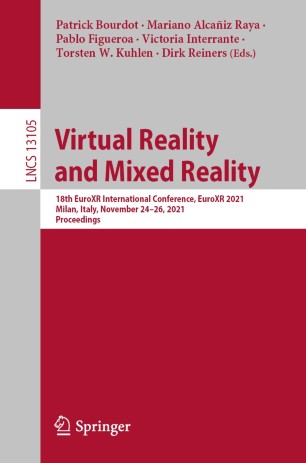Virtual Reality and Mixed Reality

We are pleased to present in this LNCS volume the scientific proceedings of EuroXR 2021, the 18th EuroXR International Conference, organized by CNR-STIIMA, Italy, which took place during November 24–26, 2021. Due to the COVID-19 pandemic, EuroXR 2021 was held as a virtual conference to guarantee the best audience while maintaining the safest conditions for the attendees. This conference follows a series of successful international conferences initiated in 2004 by the INTUITION Network of Excellence in Virtual and Augmented Reality, supported by the European Commission until 2008. Embedded within the Joint Virtual Reality Conference (JVRC) from 2009 to 2013, it was known as the EuroVR International Conference from 2014 and until last year. The focus of these conferences is to present, each year, novel Virtual Reality (VR) through to Mixed Reality (MR) technologies, also named eXtended Reality (XR), including software systems, immersive rendering technologies, 3D user interfaces, and applications. These conferences aim to foster European engagement between industry, academia, and the public sector, to promote the development and deployment of XR in new and emerging, but also existing, fields. Since 2017, EuroXR (https://www.euroxr-association.org/) has collaborated with Springer to publish the papers of the scientific track of our annual conference. To increase the excellence of this applied research conference, which is basically oriented toward new uses of XR technologies, we established a set of committees including Scientific Program chairs leading an International Program Committee (IPC) made up of international experts in the field. Eight scientific full papers have been selected to be published in the proceedings of EuroXR 2021, presenting original and unpublished papers documenting new XR research contributions, practice and experience, or novel applications. Five long papers and three medium papers were selected from 22 submissions, resulting in an acceptance rate of 36%. Within a double-blind peer reviewing process, three members of the IPC with the help of some external expert reviewers evaluated each submission. From the review reports of the IPC, the Scientific Program chairs took the final decisions. The selected scientific papers are organized in this LNCS volume according to four topical parts: Perception and Cognition, Interactive Techniques, Tracking and Rendering, and Use Case and User Study. Moreover, with the agreement of Springer and for the third year, the last part of this LNCS volume gathers scientific poster/short papers, presenting work in progress or other scientific contributions, such as ideas for unimplemented and/or unusual systems. Within another double-blind peer reviewing process based on two review reports from IPC members for each submission, the Scientific Program chairs selected four scientific poster/short papers from nine submissions (an acceptance rate of 44%). Along with the scientific track, presenting advanced research works (scientific full papers) or research works in progress (scientific poster/short papers) in this LNCS volume, several keynote speakers were invited to EuroXR 2021. Additionally, an application track, subdivided into talk, poster, and demo sessions, was organized for participants to report on the current use of XR technologies in multiple fields. We would like to thank the IPC members and external reviewers for their insightful reviews, which ensured the high quality of the papers selected for the scientific track of EuroXR 2021. Furthermore, we would like to thank the Application chairs, the Demo and Exhibition chairs, and the local organizers of EuroXR 2021. We are also especially grateful to Anna Kramer (Assistant Editor, Computer Science Editorial, Springer) and Volha Shaparava (Springer OCS Support) for their support and advice during the preparation of this LNCS volume.
September 2021
Patrick Bourdot Mariano Alcañiz Raya Pablo Figueroa Victoria Interrante Torsten W. Kuhlen Dirk Reiners

